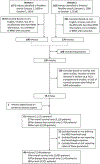Association of hematologic response and assay sensitivity on the prognostic impact of measurable residual disease in acute myeloid leukemia: a systematic review and meta-analysis
- PMID: 36261575
- PMCID: PMC11852401
- DOI: 10.1038/s41375-022-01692-0
Association of hematologic response and assay sensitivity on the prognostic impact of measurable residual disease in acute myeloid leukemia: a systematic review and meta-analysis
Abstract
Measurable residual disease (MRD) is associated with relapse and survival in acute myeloid leukemia (AML). We aimed to quantify the impact of MRD on outcomes across clinical contexts, including its association with hematologic response and MRD assay sensitivity. We performed systematic literature review and meta-analysis of 48 studies that reported the association between MRD and overall survival (OS) or disease-free survival (DFS) in AML and provided information on the MRD threshold used and the hematologic response of the study population. Among studies limited to patients in complete remission (CR), the estimated 5-year OS for the MRD-negative and MRD-positive groups was 67% (95% Bayesian credible interval [CrI], 53-77%) and 31% (95% CrI, 18-44%), respectively. Achievement of an MRD-negative response was associated with superior DFS and OS, regardless of MRD threshold or analytic sensitivity. Among patients in CR, the benefit of MRD negativity was highest in studies using an MRD cutoff less than 0.1%. The beneficial impact of MRD negativity was observed across MRD assays and timing of MRD assessment. In patients with AML in morphological remission, achievement of MRD negativity is associated with superior DFS and OS, irrespective of hematologic response or the MRD threshold used.
© 2022. The Author(s), under exclusive licence to Springer Nature Limited.
Conflict of interest statement
Figures






References
-
- Walter RB, Kantarjian HM, Huang X, et al. Effect of complete remission and responses less than complete remission on survival in acute myeloid leukemia: a combined Eastern Cooperative Oncology Group, Southwest Oncology Group, and M. D. Anderson Cancer Center Study. Journal of clinical oncology : official journal of the American Society of Clinical Oncology. 2010;28(10):1766–1771. - PMC - PubMed
-
- Chen X, Xie H, Wood BL, et al. Relation of clinical response and minimal residual disease and their prognostic impact on outcome in acute myeloid leukemia. Journal of clinical oncology : official journal of the American Society of Clinical Oncology. 2015;33(11):1258–1264. - PubMed
Publication types
MeSH terms
Grants and funding
LinkOut - more resources
Full Text Sources
Medical

